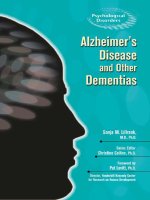Alcohol, Tobacco, and Other Drugs (ATOD) pdf
Bạn đang xem bản rút gọn của tài liệu. Xem và tải ngay bản đầy đủ của tài liệu tại đây (27.09 KB, 7 trang )
Vermont Department of Education
Health Education Grade Expectations: Grades PreK-2 - Alcohol, Tobacco and Other Drugs (ATOD) 1
Alcohol, Tobacco, and Other Drugs (ATOD) Grades PreK-2
This concept area focuses on essential content students need to know about alcohol, caffeine,
inhalants, nicotine, over-the-counter and prescription medicines, and illegal drugs.
Stem This is evident when students…
HE1: Self Management
Students will understand how to reduce their health
risks through the practice of healthy behaviors.
a. Demonstrate strategies to stay safe around
medicines, drugs, and unknown
substances, including how to avoid
exposure to second-hand smoke.
HE2: Core Concepts
Students will show an understanding of health
promotion and disease prevention concepts.
a. Identify healthy behaviors and choices,
(e.g., rules for safe use of medicines at
home and school).
b. Explain that tobacco comes in a variety of
forms and contains harmful chemicals
including nicotine that is harmful to health
and addictive.
c. Identify habits that affect health, (e.g.,
impact of tobacco on their health, both
using tobacco and being exposed to
second-hand smoke).
d. Identify household products that are
harmful if touched, ingested or inhaled.
HE4: Accessing Information
Students will demonstrate the ability to access valid
information and/or resources about health issues,
services and products.
a. Identify trusted individuals in the home,
school, and community who can provide
help and/or accurate information about
medicines, tobacco, alcohol or other
unknown substances.
HE5: Interpersonal Communication
Students will demonstrate use of skillful
communication to contribute to better health for
themselves, their families, and the community.
a. Use effective verbal and nonverbal
communication skills to express needs,
wants, and feelings (e.g., asking for help,
saying no).
b. Express information and opinions to
encourage others to make positive health
choices to be alcohol and tobacco free.
Vermont Department of Education
Health Education Grade Expectations: Grades PreK-2 - Family, Social and Sexual Health (FSSH) 2
Family, Social and Sexual Health (FSSH) Grades PreK-2
This concept area focuses on essential content students need to know about personal and family
relationships, growth and development, sexuality education, including abstinence, and sexually
transmitted infection, including HIV/AIDS.
Stem This is evident when students…
HE1: Self Management
Students will understand how to reduce their health
risks through the practice of healthy behaviors.
a. Describe ways to be responsible in school
and at home, as a family member,
classmate or friend.
b. Demonstrate healthy ways to cope with
change that may occur in families (e.g.,
pregnancy, birth, marriage, divorce,
relocation, death).
HE2: Core Concepts
Students will show an understanding of health
promotion and disease prevention concepts.
a. Identify the roles and responsibilities of
family members.
b. Identify the stages of the life cycle from
infancy to old age.
c. Identify ways to show respect for diversity
(e.g., individual differences, diverse family
structures).
HE4: Accessing Information
Students will demonstrate the ability to access valid
information and/or resources about health issues,
services and products.
a. Identify trusted individuals in the home,
school, and community, who can provide
help with health issues.
HE5: Interpersonal Communication
Students will demonstrate use of skillful
communication to contribute to better health for
themselves, their families, and the community.
a. Use effective verbal and nonverbal
communication skills to express ideas,
needs, wants, and feelings (e.g., making
friends; giving and accepting compliments
or statements of appreciation).
b. Demonstrate ways to communicate care,
consideration, and respect of self and
others.
HE7: Decision Making
Students demonstrate the ability to make decisions
that lead to better health.
a. Explain when assistance is needed in
making health-related decisions (e.g.,
tattling vs. getting help).
b. Identify people who can help make
decisions and solve problems.
Vermont Department of Education
Health Education Grade Expectations: Grades PreK-2 - Mental and Emotional Health (MEH) 3
Mental and Emotional Health (MEH) Grades PreK-2
This concept area focuses on essential content students need to know to handle emotions in positive
ways, anger and conflict management, stress management, respect, and mental health issues,
including depression and suicide.
Stem This is evident when students…
HE1: Self Management
Students will understand how to reduce their health
risks through the practice of healthy behaviors.
a. Apply effective ways to handle emotions
(e.g., fear, anger, happiness, sadness,
frustration).
b. Demonstrate ways to show respect for
feelings, rights, and property of others.
HE2: Core Concepts
Students will show an understanding of health
promotion and disease prevention concepts.
a. Describe what respect is and why it is
important.
b. Describe a variety of feelings and the
importance of expressing them in
appropriate ways.
HE4: Accessing Information
Students will demonstrate the ability to access valid
information and/or resources about health issues,
services and products.
a. Identify trusted individuals in the home,
school, and community who can provide
help with troublesome feelings and solving
problems.
HE5: Interpersonal Communication
Students will demonstrate use of skillful
communication to contribute to better health for
themselves, their families, and the community.
a. Use effective verbal and nonverbal
communication skills to express ideas,
needs, wants, and feelings.
b. Demonstrate ways to communicate care,
consideration, and respect for self and
others (e.g., making friends, giving and
receiving compliments).
HE7: Decision Making
Students demonstrate the ability to make decisions
that lead to better health.
a. Explain when assistance is needed in
making health-related decisions.
b. Predict outcomes of positive health
decisions.
Vermont Department of Education
Health Education Grade Expectations: Grades PreK-2 - Nutrition and Physical Activity (NPA) 4
Nutrition and Physical Activity (NPA) Grades PreK-2
This concept area focuses on essential content students need to know about nutrition and physical
activity.
Stem This is evident when students…
HE1: Self Management
Students will understand how to reduce their health
risks through the practice of healthy behaviors.
a. Select a variety of foods that can be eaten
for healthy snacks.
b. Create a list of foods that should be limited.
c. Identify a variety of physical activities that
are personally enjoyable.
HE2: Core Concepts
Students will show an understanding of health
promotion and disease prevention concepts.
a. Identify habits that are healthy and reduce
the risk of disease (e.g., healthy food
choices, regular physical activity, drinking
water, adequate sleep and rest).
b. Explain the importance of eating a variety
of nutrient-rich foods.
c. Identify a variety of nutritious food choices.
d. Identify a variety of ways to be physically
active and raise heart rate.
HE3: Analyzing Influences
Students will show understanding of how culture,
media, peers, family, and other factors influence
healthy behaviors.
a. Explain how culture, media, peers, family
and other factors influence eating
behaviors and physical activity.
HE5: Interpersonal Communication
Students will demonstrate use of skillful
communication to contribute to better health for
themselves, their families, and the community.
a. Demonstrate appropriate communication
skills when asking adults/caretakers to
offer healthy foods and time for physical
activity.
HE6: Goal Setting
Students will demonstrate the ability to set personal
goals to enhance health.
a. Set a short-term personal health goal for
healthy eating and physical activity.
HE7: Decision Making
Students demonstrate the ability to make decisions
that lead to better health.
a. Explain when assistance is needed in
making health-related decisions (e.g.,
family members and other adults help
students make healthy food choices).
Vermont Department of Education
Health Education Grade Expectations: Grades PreK-2 - Personal Health and Wellness (PHW) 5
Personal Health and Wellness (PHW) Grades PreK-2
This concept area focuses on essential content students need to know about personal hygiene,
including dental care, and disease prevention.
Stem This is evident when students…
HE1: Self Management
Students will understand how to reduce their health
risks through the practice of healthy behaviors.
a. Demonstrate the skills to promote health
and reduce the spread of germs (e.g.,
proper hand washing, proper tooth
brushing techniques).
HE2: Core Concepts
Students will show an understanding of health
promotion and disease prevention concepts.
a. Identify basic personal hygiene habits
required to maintain health (e.g., caring for
teeth, gums, eyes, ears, nails).
b. Recognize the signs and symptoms of
common illnesses (e.g., fever, rashes,
coughs, congestion, wheezing).
HE3: Analyzing Influences
Students will show understanding of how culture,
media, peers, family, and other factors influence
healthy behaviors.
HE4: Accessing Information
Students will demonstrate the ability to access valid
information and/or resources about health issues,
services and products.
a. Identify community health service providers
(e.g., dentists, nurses, physicians,
paramedics, who can provide help with
personal health issues).
HE5: Interpersonal Communication
Students will demonstrate use of skillful
communication to contribute to better health for
themselves, their families, and the community.
a. Use effective communication skills to
encourage others to make positive choices
for personal health and wellness.
Vermont Department of Education
Health Education Grade Expectations: Grades PreK-2 - Violence and Injury Prevention (VIP) 6
Violence and Injury Prevention (VIP) Grades PreK-2
This concept area focuses on essential content students need to know about fire and water safety;
first aid prevention and care for injuries; pedestrian, bicycle, and vehicle safety; use of protective
equipment, including seat belts; personal safety; and violence prevention, including bullying, hazing,
and harassment.
Stem This is evident when students…
HE1: Self Management
Students will understand how to reduce their health
risks through the practice of healthy behaviors.
a. Demonstrate safety skills for a variety of
situations, including safe pedestrian
behaviors, fire or other emergency, use of
safety/protective gear in recreation,
precautions around water and dangerous
objects/weapons.
b. Demonstrate the ability to apply rules and
actions to use in a situation when weapons
or dangerous objects may be present.
c. Describe dangerous and risky situations
that need to be reported to an adult.
d. Apply strategies to avoid or get away from
situations that threaten personal safety.
e. Demonstrate basic first aid and how to call
911 to get help in emergencies.
HE2: Core Concepts
Students will show an understanding of health
promotion and disease prevention concepts.
a. Differentiate between safe and risky
behaviors.
b. Identify safety practices for home and
school (e.g., rules for pedestrian and traffic
safety, fire, weather, water, recreation
safety).
c. Identify safety hazards that may exist in
home/school (e.g., medicines, household
products, unknown substances) and
potentially dangerous objects/weapons
(e.g., matches, broken glass, knives,
guns).
d. Identify safe behaviors around strangers
(e.g., not getting in cars or taking treats
from strangers).
e. Distinguishing between appropriate and
inappropriate touch.
f. Describe routines to follow in emergency
situations (e.g., fire, lockdown drills, calling
911).
g. Explain the difference between tattling and
reporting bullying or aggression.
Vermont Department of Education
Health Education Grade Expectations: Grades PreK-2 Violence and Injury Prevention (VIP) 7
Violence and Injury Prevention (VIP) - Continued Grades PreK-2
Stem This is evident when students…
HE4: Accessing Information
Students will demonstrate the ability to access valid
information and/or resources about health issues,
services and products.
a. Identify trusted individuals in the home,
school, and community who can provide
help with safety issues.
HE5: Interpersonal Communication
Students will demonstrate use of skillful
communication to contribute to better health for
themselves, their families, and the community.
a. Demonstrating verbal and nonverbal ways
to ask trusted adults for help, including how
to report unsafe, scary, or hurtful situations
in the home, school or community.
b. Demonstrating ways to refuse or report
inappropriate touch.
c. Demonstrating what to say and do when
witnessing bullying or other potentially
violent situations.









